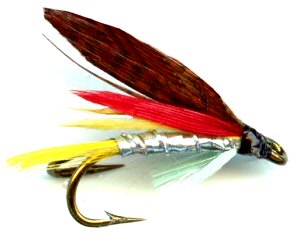The Soldokka (Silver Dollar) Double Hook Wet Fly
When the British Victorian and Edwardian Fly Fishermen wanted some adventurous fly fishing they would book themselves a berth on a North Sea Passenger ship and sail to Norway. Here the fishing for Trout and Salmon in majestic mountainous Norwegian Fjords was breath taking.

DOUBLE HOOKED TROUT AND SALMON FLIES USED IN THE FJORDS OF NORWAY. Hook size 10 12 14 - $US each
They introduced some of the classic British fly fishing patterns to the local Norwegian fly fishermen and guides but the Norwegians also developed their own designs that are now proven fish taking weapons: Telemarkskongen, Butcher, Bloody Butcher, Heggeli, Solvdokka, Olsen, Bathakorva, Silver and Gray, Pålsbu, Zulu, Silver Zulu, Teal Blue and Silver. The Norwegians have also kept a liking for using double hooked flies. This selection of double hook wet flies are what you will find in most Norwegian fly fishing tackle shops but at less than half the price you will have to pay in Norway. On my last trip to Norway I primed my fly box with these flies. Every one took a fish. They are ideal for Fjord Loch and river fishing in Alaska, Scotland, British Columbia, Canada and Norway
A wet fly is designed to be fished below the water's surface. They are tied as deceivers or attractors. The success of the wet fly often depends far more on its action in the water than on its resemblance to a particular insect, but this is not always the case. When fish are on the feed the actual pattern is generally not important, but when the fish are preoccupied or need tempting the angler must use ingenuity to discover what the fish are feeding on and what color they are taking. When fishing wet flies, it is important to remember that the higher the wave on the water the higher the fly hook size can be, but still take into account the brightness and clarity of the water.
Trout do see subsurface insects with wings. Some flies begin to hatch below the water surface. The Baetis group of up-winged flies swim or crawl beneath the surface as adult spinners in order to lay egg. There are occasions when duns and spent spinners are swamped by the current and forced under the water surface. Emerging duns that have been unable to get rid of their nymphal case or at the time of emerging are drowned when they float under rough water that is flowing over a large rock or ledge are also hunted by the fish. The trout on purpose lurk in slack water near eddies and small plunge pools to look out for these type of snacks. Clearly a trout does see winged insects under the surface at certain times of the year so be prepared with a selection of different colored wet flies for when the fish are not taking from the surface.
FLY FISHING TACTICS FOR FISHING IN THE RAIN
I like to fish wet flies in the rain. If you are one of those fine weather fishermen you are missing a lot of sport. On sunny days the fish swim near the bottom of the river, lake or stream for a number of reasons. They do not have eye lids and the sun can damage the eyes. More importantly the warmer the water becomes the less oxygen it can hold. Fish find warm water uncomfortable. The colder the water temperature the more oxygen the water can hold. When it rains the disturbance caused on the water surface increases the oxygen content of the upper levels of water because when the water droplets force their way through the water surface air gets trapped behind it. If it is raining it normally means the sky is overcast and therefore the temperature of the water decreases. This cooling effect is also helped by the rain drops which are normally cold and help cool the upper water levels of the lake or river to a more pleasant fish friendly environment.
They feel safer as choppy water makes them invisible to birds of prey. Heavy rain will knock airborne and surface insects down and into the water. More fish than normal rise from their bottom feeding location to the surface to feed from this bounty of drowned insects. Heavy rain also washes terrestrial insects like ants, beetles and Hoppers into the water from the land, overhanging trees and shrubs. Summer storms are primetime for subsurface fishing with a wet fly. Further advantages of fishing in heavy rain is that perfect fly presentation is less important. A fish who is stimulated by the abundance of drowned insect food, whilst on the look out for predators, will not have time to consider such things.
When the all the fair-weather fishermen are hiding under trees, in fishing huts or in their cars to keep dry, you will reap the rewards of some exciting fishing if you stay out in the rain. Just cast out your fly and let the rain drown it, just like what is happening to the real insects. Do not add any floatant. It is best to cast frequently as you will cover more water and I have found that the fly is normally taken just after it has broken the water surface. Fishing in heavy rain is an ideal time to try out new patterns . Trout have learned to expect a variety of different foods, not normally available to them, washed into the lake or river from various sources. They have learned to expect this yummy bounty when the skies darken and the heavy rain drops pound the water surface.

